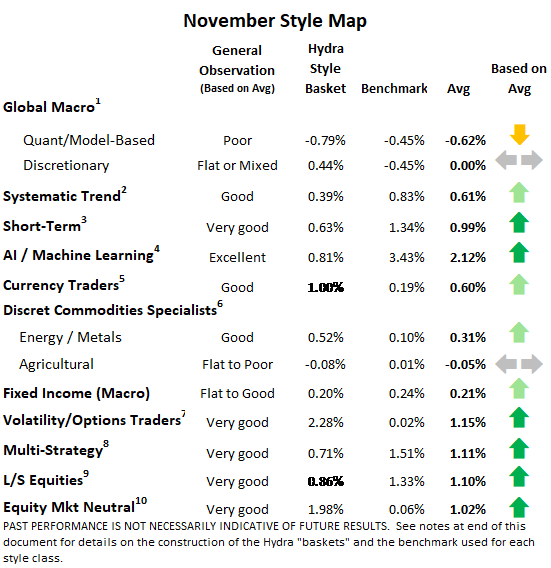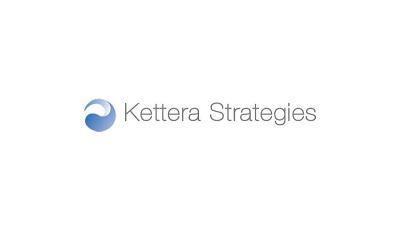Kettera Strategies Heat Map - November 2019
The pattern of returns seen by Global Macro managers was very similar to October. Most discretionary programs we track ended the month flat to positive, fueled mostly by equities-related positions. The “quant,” or model-driven, macro programs did not fare as well; setbacks for the quants seemed to come largely from G10 currencies and in the US yield curve.
Options- and volatility-based programs generally fared well in November – perhaps, as an overall category, one of their best months of the year.
On average, most of the short-term and higher-frequency programs we follow also posted one of the best performing months of the year. The equity index markets, again, seemed to offer the most opportunity – on both the long and short side – with fixed income as a distant second.
Although most of the larger traditional systematic trend strategies sustained a “downward correction” in September and October (to what has otherwise been a solid year), November was a “comeback” month. The leading winning sectors were equity indices and currencies, with the G10 currencies generally detracting.
Many energy specialists posted profitable months, particularly those with a relative value or spread approach.
Equity strategies benefited from buoyant performance even in the face of substantial political headwinds. The performance of market neutral strategies (outside of our style bucket) somewhat varied as there was substantial rotation within the market.

**********
For the “style classes” and “baskets” presented in this letter: The various style classes set forth in the table on Pages 1 and 2 are classifications drawn by Kettera Strategies in their review of candidate programs for the Hydra Platform. The arrows represent the performance during the month: E.g. the sideways arrow indicates that the class overall (from an average) was largely flat; a solid red down arrow indicates the class (on average) was largely negative compared to most months. This determination is made from an average of two inputs: (i) performance of a “style basket” created by Kettera for research purposes to track the category and (ii) the third-party benchmark for that category. The “style basket” for a class is crated from monthly returns (net of fees) of programs that are either: (1) currently listed programs on Hydra, (2) programs that have been de-listed or terminated from Hydra (for a holdover period of 12 months), or (3) programs currently under review by Hydra with an expectation of being on-boarded. The weighting of a program depends upon which of these three groups the program falls into; programs of a common group are equally weighted (and not volatility adjusted). These baskets are not investment products or index products being offered to investors. They are meant purely for analysis and comparison purposes, so the reader can gain a greater understanding of a style class. These also were not created to stimulate interest in any underlying or associated program. Nonetheless, as these research tools may be regarded to be “hypothetical” combinations of managers, please read the following warning: hypothetical performance results have many inherent limitations, some of which are described below. No representation is being made that any product or account will achieve profits or losses similar to those shown. In fact, there are frequently sharp differences between hypothetical performance results and the actual results subsequently achieved by any particular trading program. One of the limitations of hypothetical results is that they are generally prepared with the benefit of hindsight. In addition, hypothetical trading does not involve financial risk, and no hypothetical trading record can completely account for the impact of financial risk in actual trading. There are numerous other factors related to the markets in general or to the implementation of any specific trading program which cannot be fully accounted for in the preparation of hypothetical performance results and all of which can adversely affect actual trading results.
Benchmark sources:
1-The Hedge Fund Intelligence Global Macro Index and HFI Currency Index
2-The Societe Generale Trend Index and SG CTA Index
3-The Societe General Short-term Traders Index: (same link as above)
4-The Eurekahedge AI Hedge Fund Index
5-The BarclayHedge Currency Traders Index and BTOP FX Traders Index
6- S&P GSCI Metals & Energy Index and S&P GSCI Ag Commodities Index
7-The CBOE Eurekahedge Relative Value Volatility Hedge Fund Index
8-The Eurekahedge-Mizuho Multi-Strategy Index: (See above)
9-The Eurekahedge Long Short Equities Hedge Fund Index: (See above)
10-BarclayHedge Equity Market Neutral Index
11- The Eurekahedge Market Neutral Hedge Fund Index: (See above)
Indices and other financial benchmarks shown are provided for illustrative purposes only, are unmanaged, reflect reinvestment of income and dividends and do not reflect the impact of advisory fees. Index data is reported as of date of publication and may be a month-to-date estimate if all underlying components have not yet reported. The index providers may update their reported performance from time to time. Kettera disclaims any obligation to verify these numbers or to update or revise the performance numbers.
***
The views expressed in this article are those of the author and do not necessarily reflect the views of AlphaWeek or its publisher, The Sortino Group
© The Sortino Group Ltd
All Rights Reserved. No part of this publication may be reproduced, stored in a retrieval system or transmitted in any form or by any means, electronic, mechanical, photocopying, recording or scanning or otherwise, except under the terms of the Copyright, Designs and Patents Act 1988 or under the terms of a licence issued by the Copyright Licensing Agency or other Reprographic Rights Organisation, without the written permission of the publisher. For more information about reprints from AlphaWeek, click here.








